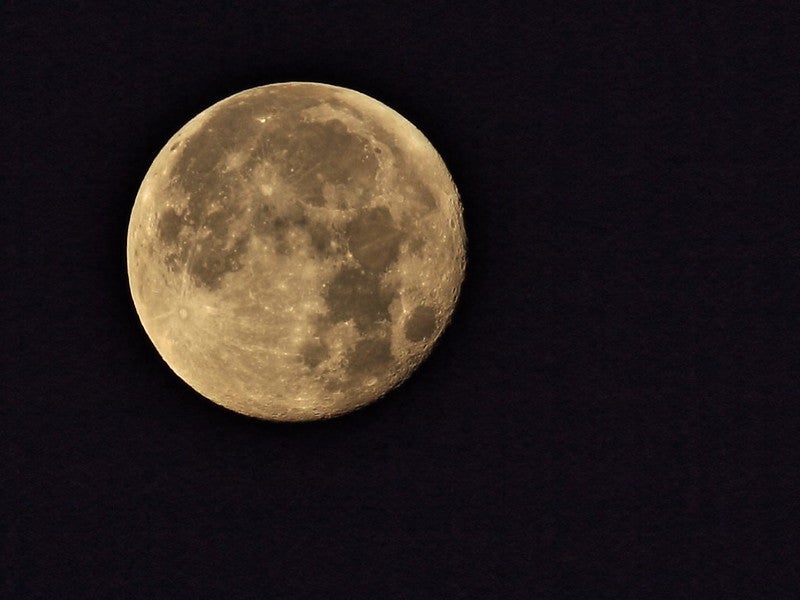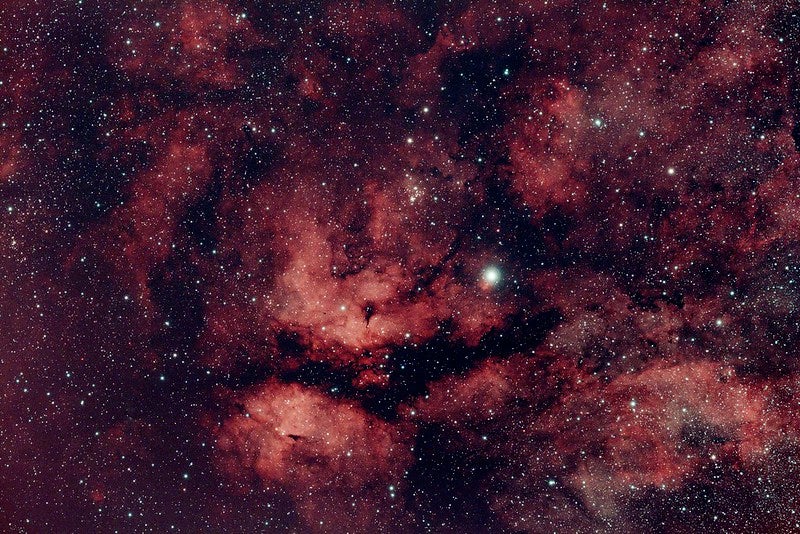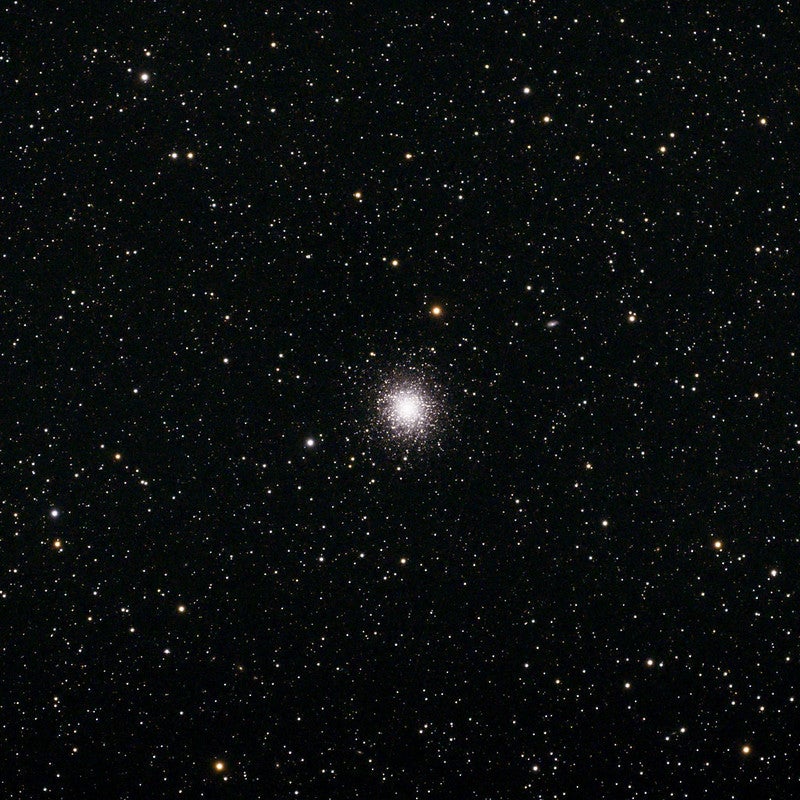
Friday, January 19
Mars has finally reappeared after its solar conjunction, shining close to Mercury in the pre-dawn sky. We’ll catch up with these two a bit later in the week as they close in for a conjunction on the 27th.
Meanwhile, the Moon passes 3° north of Uranus at 3 P.M. EST. An hour after sunset, this pair is high in the southeastern sky, hanging near a few naked-eye stars in eastern Aries. You’ll find them directly to the right of the Pleiades star cluster (M45) in Taurus.
The Moon is now roughly 70 percent lit, a bright waxing gibbous. It lies under an arc of three stars (from east to west): 5th-magnitude 63 Arietis and Zeta (ζ) Arietis, and 4th-magnitude Delta (δ) Arietis (also known as Botein). These stars may be challenging to spot in the bright moonlight. Luna’s bright light will also make it impossible to find magnitude 5.7 Uranus with the naked eye even from a dark site, so you’ll need binoculars or a telescope. The distant ice giant is now roughly 4.4° southwest of the Moon; through a scope, it will show off a 4″-wide disk that looks like a grayish, “flat” star.
Much easier to spot should be the relatively bright “V” of Taurus’ face to the east (the Moon’s lower left); note the Bull’s bright red “eye.” That’s the red giant star Aldebaran, glowing at magnitude 0.9. Intrinsically, this star is more than 400 times as luminous as the Sun!
Sunrise: 7:19 A.M.
Sunset: 5:03 P.M.
Moonrise: 11:59 A.M.
Moonset: 1:50 A.M.
Moon Phase: Waxing gibbous (67%)
*Times for sunrise, sunset, moonrise, and moonset are given in local time from 40° N 90° W. The Moon’s illumination is given at 12 P.M. local time from the same location.

Saturday, January 20
Pluto, now in the constellation Capricornus, is in conjunction with the Sun at 9 A.M. EST.
Comet 12P/Pons-Brooks, recently recorded at magnitude 9.2, is currently in Cygnus the Swan. This region is setting in the west after sunset but still affords an hour or two of good observing from a dark location.
Find the cross-shaped body of the Swan first, about 25° high an hour after sunset. The star in the middle of the cross is magnitude 2.2 Sadir (Gamma [γ] Cygni). Look just north-northeast of this star to find NGC 6910, a Y-shaped open cluster that shines at magnitude 7.5. These young stars sit near the soft glow of the large emission nebula IC 1318 — stay a while and enjoy this deep-sky target with a low-power eyepiece and a medium-sized telescope if you have one.
Next, slide your telescope about 4° southeast of Sadir to find Pons-Brooks. It lies just southeast of a line of three 6th- to 7th-magnitude stars, running northeast to southwest. The comet should look like a gently glowing gray ball of fuzz. Follow it as long as you can until it sinks into the thicker, more turbulent air near the horizon a few hours later.
Sunrise: 7:18 A.M.
Sunset: 5:05 P.M.
Moonrise: 12:33 P.M.
Moonset: 3:01 A.M.
Moon Phase: Waxing gibbous (77%)
Sunday, January 21
The window for observing Saturn is closing fast as the planet sets earlier each night. It’s already just 20° high in the southwest an hour after sunset, glowing at 1st magnitude about 0.5° south of Sigma (σ) Aquarii in Aquarius.
Through a telescope, Saturn’s disk stretches some 16″ across and its rings span about 36″. Take your time enjoying the ringed planet’s visage, particularly the northern view of the rings. By next year, the rings will appear edge-on, then switch to a southern view looking up at them from below.
Overnight, the large and bright moon Titan will pass due south of Saturn. This evening before Saturn sets, Titan is visible about 30″ southeast of the planet’s center. Come back tomorrow to see how the far the moon has moved — in a day, it will sit nearly 50″ to Saturn’s southwest. Titan’s orbit takes nearly 16 days to complete, so it won’t return to the same spot for roughly two weeks.
Sunrise: 7:17 A.M.
Sunset: 5:06 P.M.
Moonrise: 1:14 P.M.
Moonset: 4:09 A.M.
Moon Phase: Waxing gibbous (85%)

Monday, January 22
Asteroid 4 Vesta is carving a slow path through the constellation Taurus this month. Tonight, it sits near a magnitude 4.9 field star not far from the famous Crab Nebula (M1).
The challenge is that there’s a bright Moon nearby, which will likely wash out the nebula; still, magnitude 7.1 Vesta is bright enough to readily capture with binoculars or a small scope even with the background moonlight. You’ll see the main-belt world as a point of light about 5.5′ west-southwest of the field star 114 Tau. Meanwhile, the Crab lies just over 1.5° east of Vesta, so if you have a large-aperture scope, give it a try. At best, you may see the nebula as a soft grayish-white glow, almost like the remains of a fingerprint on your eyepiece.
About 1.1° southeast of the Crab is the bright star Zeta (ζ) Tauri, also called Alheka. This star marks the eastern horn of Taurus, while Elnath, Taurus’ beta star, is the Bull’s western horn. Elnath also holds the designation of Gamma (γ) Aurigae as part of Auriga just to Taurus’ north. According to the late stellar expert Jim Kaler, Elnath is one of only two stars to hold such dual designations (the other is Alpheratz, which is both Alpha [α] Andromedae and Delta Pegasi).
Sunrise: 7:17 A.M.
Sunset: 5:07 P.M.
Moonrise: 2:03 P.M.
Moonset: 5:14 A.M.
Moon Phase: Waxing gibbous (91%)

Tuesday, January 23
With the gibbous Moon in the sky, only the brightest deep-sky objects are easily accessible. But if you’re an early riser, one of the best available is M13, the great globular cluster in Hercules.
You’ll find our target about 40° above the eastern horizon at 4:30 A.M. local time. The cluster sits near magnitude 3.5 Eta (η) Herculis, about 2.5° south of this star. Or, you can use the bright stars Vega in Lyra and Arcturus in Boötes to locate it — just find these two stars on the sky and draw an imaginary line between them. Starting at Vega and moving southwest, M13 is one-third of the distance from Vega to Arcturus.
Spanning about 20′ on the sky, M13 glows with a total magnitude of 5.8. It’s just visible to the naked eye under dark conditions, but the Moon this morning will likely wash it out for the unaided eye. Fortunately, binoculars or any scope should pick it up. Bigger telescopes will simply bring out an increasing number of this ancient cluster’s members, which number more than 100,000. Observers with larger scopes (8 inches or more) may even start to pick out chains and clumps of suns within the cluster’s more spherical general shape.
Sunrise: 7:16 A.M.
Sunset: 5:08 P.M.
Moonrise: 3:00 P.M.
Moonset: 6:10 A.M.
Moon Phase: Waxing gibbous (96%)
Wednesday, January 24
Mars is slowly growing in visibility as an early-morning object. The Red Planet glows at magnitude 1.3 and is nearly 3° high in the southeast 40 minutes before sunrise this morning. It is closing in on Mercury, now 2° to its west (upper right) and a much brighter magnitude –0.3. The two will continue growing closer by the day until they pass within 0.2° of each other on the morning of the 27th. We’ll certainly include that event in our column next week.
The brightest object in the morning sky is Venus at magnitude –4, which hangs to the far upper right (west) of Mercury and Mars. All three planets are now in Sagittarius, whose dim stars quickly vanish as twilight grows. Venus is some 12.5° high 40 minutes prior to sunrise and easy to observe even (in fact, especially) in the brightening sky. With an apparent width of 13″, Venus’ gibbous phase — some 84 percent lit — is readily discernible through a telescope.
Mercury is also in a gibbous phase, roughly 82 percent lit. It spans less than half the width of Venus, though, at 6″. Mars appears smaller still, just 4″ across, with a face that looks fully illuminated.
Sunrise: 7:15 A.M.
Sunset: 5:09 P.M.
Moonrise: 4:01 P.M.
Moonset: 6:58 A.M.
Moon Phase: Waxing gibbous (99%)
Thursday, January 25
Full Moon occurs at 12:54 P.M. EST. The January Full Moon is also called the Wolf Moon, and you can see it rising in the east just as the Sun is setting in the west. That’s because the Full Moon always rises and sets directly opposite the Sun. Full Moons in particular often look huge as they sit near the horizon, then appear to shrink once higher in the sky. This change, however, is an optical illusion — albeit one that scientists can’t yet fully explain.
Seeing intricate detail on our satellite is hard during the Full phase because the Sun is directly over the lunar landscape, meaning shadows are at their shortest. But although it’s not the best time to study the terrain up close, Full Moon offers a great chance to view the entire lunar nearside to get an idea of the landscape as a whole.
The dark patches are called maria, which is Latin for seas. These never held water, though, and instead are ancient lava flows that either spread over the landscape or welled up from below. They are younger than the lighter, more rugged regions of the lunar south and southeast.
Several large craters with stunningly long rays (light streaks of excavated material) are visible on the Full Moon as well. Tycho is the prominent crater in the south, while Stevinus lies close to the southeastern limb and Copernicus dominates the eastern portion of Oceanus Procellarum in the lunar west.
Sunrise: 7:15 A.M.
Sunset: 5:10 P.M.
Moonrise: 5:05 P.M.
Moonset: 7:37 A.M.
Moon Phase: Full
Friday, January 26
Let’s return to Saturn in the evening sky to check out its two-faced moon Iapetus at inferior conjunction. It’s one the best times to spot this moon, which now sits just 27″ north of the planet and glows at 11th magnitude.
Remember to try your luck earlier rather than later — try an hour or two after sunset, when Saturn is still above the horizon glow in the southwest. Once you’ve got the planet in your sights, you’ll notice immediately how Titan, the brightest moon, has moved — it now sits far to Saturn’s west, roughly 2.5′ away. About half that distance to the west is 10th-magnitude Rhea; Tethys and Dione (both also 10th magnitude) are closer to the ringed world, with Tethys near the northwestern limb, sitting above the rings. Dione is northeast of the planet’s center, farther out than the eastern tip of the rings.
Those on the U.S. West Coast may be able to catch Tethys disappearing behind the planet around 6:30 P.M. PST. Mimas and its shadow begin a transit of Saturn just south of the rings as the planet is setting — an extremely challenging event, though photographers with high-speed cameras and an observing site at higher elevations might just get lucky and catch the start of it around 7:15 P.M. PST.
Sunrise: 7:15 A.M.
Sunset: 5:12 P.M.
Moonrise: 6:09 P.M.
Moonset: 8:08 A.M.
Moon Phase: Waning gibbous (99%)

Sky This Week is brought to you in part by Celestron.









